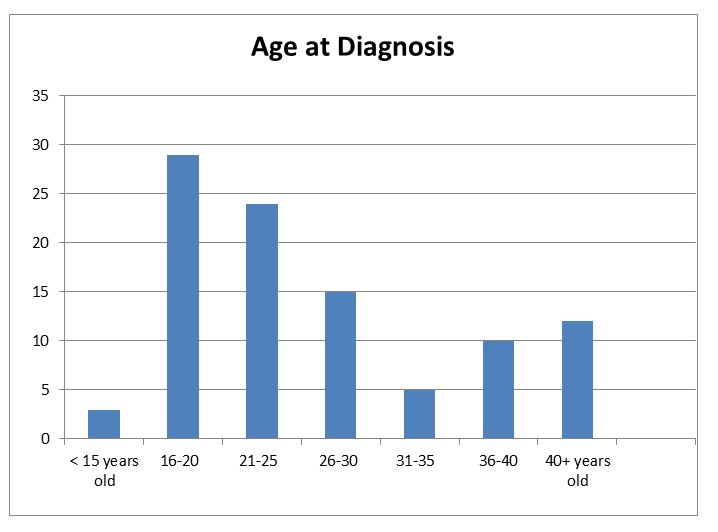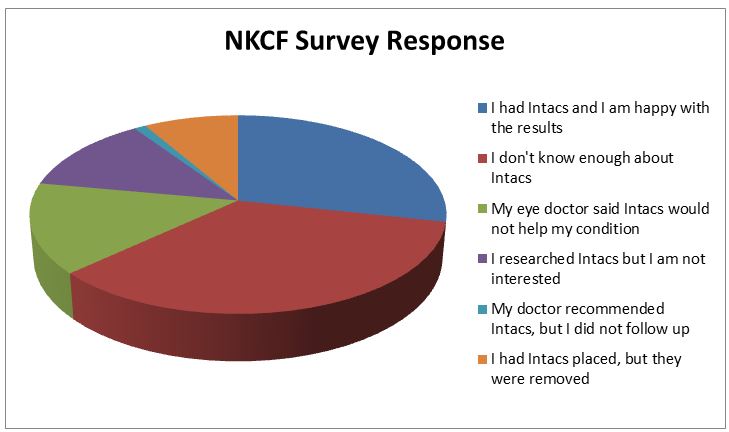We asked our KC community for their experience and opinion on INTACS -- here's what we learned.
Intrastromal Corneal Ring Segments (Intacs®) were introduced in the early 2000s as a surgical method to flatten the cornea and improve vision. There are doctors and patients who swear by the technology, but many eye doctors who treat keratoconus patients neither recommend implanting the devices, nor refer their patients to surgeons for the procedure.
Intacs® are not a cure. They will they stop progression of keratoconus. In the best outcomes, they offer increased tolerance of contact lenses, and improvement in visual acuity. As with all procedures, understanding the likely outcome keeps expectations in line with results.
NKCF asked our newsletter subscribers to share their Intacs experience. We received 95 responses. Our informal survey was nonscientific in that we did not monitor who responded or verify their remarks. Here are some comments that we received:
Not a cure, but…
Intacs® are not a cure. They will they stop progression of keratoconus. In the best outcomes, they offer increased tolerance of contact lenses, and improvement in visual acuity. As with all procedures, understanding the likely outcome keeps expectations in line with results.
NKCF asked our newsletter subscribers to share their Intacs experience. We received 95 responses. Our informal survey was nonscientific in that we did not monitor who responded or verify their remarks. Here are some comments that we received:
Survey says…
NKCF asked our newsletter subscribers to share their Intacs experience. We received 95 responses. Our informal survey was nonscientific in that we did not monitor who responded or verify their remarks.
Here are some comments that we received:
- Had Intacs done in 2004 in one eye. Was able to wear soft toric lenses with comfort and decent vision since then.
- Intacs in both eyes in 2006. Very happy with the outcome. All of the medical providers that I’ve seen have always been impressed with the condition of my eyes.
- Helps with night vision. Makes RGP fitting harder.
- I still have to wear very uncomfortable contacts to correct my vision.
- I had Intacs but did not achieve any significant improvement in vision or cornea shape.
- It didn’t improve vision and now makes any treatment very difficult.
- While it improved by vision, it didn’t really alter any of the issues I had related to KC, which is why I had it in the first place.
Here is what we learned:
 Our survey was completed by men (55%, n=52) and women (45%, n=43). The average age was 45, with a range from 23 – 75 years old.
Our survey was completed by men (55%, n=52) and women (45%, n=43). The average age was 45, with a range from 23 – 75 years old.
Like the majority of individuals with KC, they were diagnosed as teenagers or young adults.
Nearly a quarter of the respondents were patients who had Intacs surgery and were happy with the results (24.2%).
More than one third of those who responded to the survey said they didn’t know enough about Intacs to have an opinion (34.8%).
The next largest groups consisted of patients who were advised by their doctor that they were not a good candidate for corneal ring segments (14.7%), and those who had undergone Intacs surgery, but were unhappy with the results, or had their Intacs subsequently removed for medical reasons or vision concerns (13.6%).
The remaining responses were patients who researched Intacs but decided against the procedure (11.5%) and one patient whose doctor recommended the procedure, but she did not follow-up (1%).
Thank you to those who completed our informal survey.
The responses seem to validate that Intacs are not right for every keratoconus patient, but for a select group, the patients are satisfied and the results are good.


